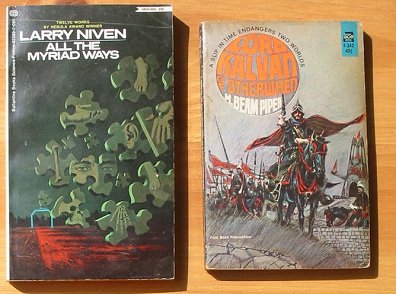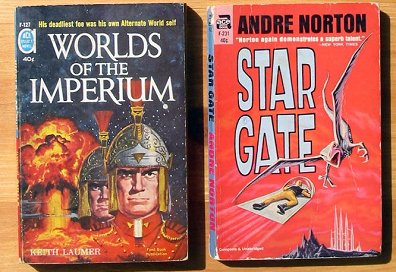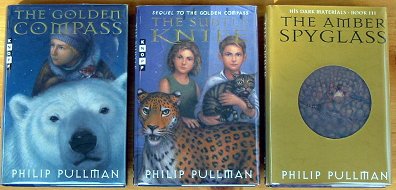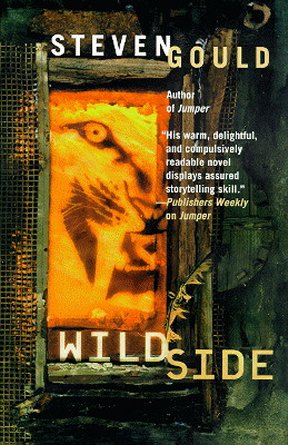

|
An outside observer cannot know if the cat is dead or alive until the box is opened; the experiment is represented by a quantum wavefront in which the cat is both alive and dead. The act of observation causes the wavefront to collapse and leaves us with a dead or a living cat. Everett claims that opening the box causes the creation of two new parallel realities, one with a dead cat and a second with a live one. (I leave it to the reader to decide which they prefer.) Taken to its logical extreme, this means that every possible outcome of every point in the history of spacetime created a new universe and that all these possibilities exist simultaneously in parallel in what has been called the multiverse. (EDITOR'S NOTE: if this seems at all confusing to you - and it may indeed to some of us who aren't physicists or SF aficionados - click here for an excellent layman's discussion of the Many Worlds Theory.) Some have used this idea as a means of sidestepping the paradoxes of time travel. The act of traveling back in time creates a new universe in the multiverse and changes have no affect on the original universe. Alternate history stories - e.g., what if the South had won the Civil War? - may be thought of as parallel worlds, given that the change can be traced to some critical point in the past where history took a different path. The so-called Everett Interpretation is difficult for some to accept as it seems to eliminate the concept of free will. Larry Niven's story "All the Myriad Ways" features police detective Gene Trimble sitting at his desk and considering the implications of an escalating wave of senseless crimes and suicides that started soon after the Crosstime ships started traveling to alternate parallel worlds. The story ends with Trimble sitting at his desk and considering the business end of his service revolver. As written, the story has ten different, parallel endings, representative of the essentially infinite number of endings possible under the Everett Interpretation.

Quantum theory aside, SF has adapted this idea in a variety of ways. Some stories, as discussed above, take the idea to its logical extreme. Another approach is to assume that closely related universes re-merge and that some level of difference is required to form a distinct parallel universe. This is apparently the model that Robert Sawyer uses in his Neanderthal Parallax trilogy (see below). Some authors have used the Many-Worlds idea to unify apparently unrelated writings into a single framework. Michael Moorcock has developed the concept of the Eternal Champion, who takes on various identities through various ages across the universes of the multiverse (see his Elric of Melnibone as well as his Jerry Cornelius stories). In fact, Moorcock is credited by the Oxford Universal Dictionary with one of the first printed uses of the word multiverse. Robert Heinlein went one step further in The Number of the Beast (London: New English Library, 1980; NY: Ballantine Books, 1980 - $100+), which begins in our own normal reality (if you can call a California house party normal) and quickly escalates to involve cross-parallel travel and the discovery of alternate realities, where some of Heinlein's earlier fictional characters are real. This is continued in The Cat Who Walks Through Walls (NY: Putnam, 1985 - $20-). Many early treatments of the parallel worlds theme involve a dominant reality that develops the technology to travel between the worlds, using it to explore/exploit/protect/control the multiverse. This often leads to a police or military style organization that deals with activities ranging from criminal activity to full-scale war fought on multiple fronts across the realities. One example is H. Beam Piper's Paratime Police stories, most recently collected in The Complete Paratime (Ace paperback, 2001), including several short stories and the novel Lord Kalvan of Otherwhen. Another example is Keith Laumer's Imperium novels. In the first, Worlds of the Imperium (Ace Double PB F127, 1962 - $10+), the Imperium of alternate reality Zero Zero Stockholm travels to our reality to recruit Brion Bayard in a desperate attempt to stop an attacking universe that threatens us all. The leader of this attacking army is an alternate Brion Bayard. Sequels include The Other Side of Time, Assignment in Nowhere, and Zone Yellow. Finally, there is Andre Norton's Time Wardens series, which includes Crossroads of Time (Ace Double PB D-164, 1956 - $20+) and Quest Crosstime (Ace PB G-595, 1965 - $5). An unrelated title by Andre Norton, Star Gate (Ace PB 1958 - $5), is also of interest in discussing alternate worlds.

Of course, this article would be incomplete without at least mentioning Roger Zelazny's Amber series. The first in the series, Nine Princes in Amber (London: Faber & Faber, 1972 - $500+; NY: Doubleday, 1970 - $300+?), introduces the palace intrigues of the royal family of Amber, the one true world. All other realities are mere shadows of Amber. However, a discussion of the Amber series is beyond the scope of this article.
Three Notable Many Worlds Authors1. Philip Pullman His Dark Materials Trilogy Northern Lights (London: Point/Scholastic, 1995. ISBN:0590541781) Pricing for this book starts at $1000 for poor ex-lib copies! Fine/Fine copies list in the $6000 to $9000 range. Beware of copies with the number line "4 6 8 10 9 7 5 3 1." This is a printers mistake and actually represents a third printing, even though the "1" is present. AKA The Golden Compass (NY: Knopf, 1996. ISBN:0679879242) $100+ The Subtle Knife (London: Scholastic, 1997. ISBN:0590542435) $1000+ (NY: Knopf 1997. ISBN: 0679879250) $150+ The US edition was moderately remaindered. Presence of a remainder mark cuts the value by at least half. The Amber Spyglass (London: Scholastic, 2000. ISBN: 0590542443) $100+ (NY: Knopf 1997. ISBN:0679879269) $15+ The US edition was heavily remaindered, so presence of a remainder mark negates the value. Also, the DJ has die cut circle to front panel that shows an illustrated board below. This is very prone to damage.

Originally published in the UK, Pullman's His Dark Materials trilogy is a remarkably profound and imaginative work. It is at times funny and sad, uplifting and terrifying, but consistently intelligent and never condescends to the reader. Initially overlooked as a mere children's fantasy, the trilogy has been recognized by critics and readers as a major work echoing themes dramatized by John Milton (Paradise Lost), William Blake, and C.S. Lewis. Some have even characterized His Dark Materials as a literary rebuttal of Lewis' Narnia books. This series has garnered a number of nominations and awards, including the Carnegie Medal and The Guardian Fiction Prize (in the UK, for Northern Lights), a 2001 World Fantasy Award nomination (for The Amber Spyglass), and the 2002 Whitbread Book of the Year (for The Amber Spyglass) - the first time this award has been given to a title from the Children's Literature category. The trilogy has also been adapted as a radio drama for BBC Radio Four, and a 6-hour theatrical version has been performed at London's Royal National Theatre. The story centers on Lyra Belacqua, a young orphan growing up as a ward of the University at Oxford. But this is not our Oxford. Lyra lives in a world where everyone has a shape-shifting dæmon; a world of magic and orthodox religion, of witches and talking warrior polar bears. Lyra learns that reality is made up of an infinite number of parallel universes, and while on a quest to rescue her kidnapped friend Roger, she helps to recover the key that opens the way between these parallel worlds. Unflinchingly brave and fiercely loyal to her friends, Lyra's quest ultimately places her in a decisive role in the rebellion against God Himself, with the fate of the universes in her hands. A hardback UK set of first printings of this trilogy (in practically any condition) is astronomically priced, and will remain so. UK publishers in general and children's publishers in particular produce fairly small runs of HB first printings and often have simultaneous trade paperback releases. Many of the hardback copies end up in libraries, making collector grade copies exceedingly rare. Other examples of this phenomenon include the first few Harry Potter books, as well as Jasper Fforde's The Eyre Affair and Eoin Colfer's Artemis Fowle. There is talk of bringing the stage production of His Dark Materials to the US, and of course the film rights have been purchased, so I think that values of the more reasonably priced US Knopf editions will climb significantly over time, particularly if you can get them signed. If investing in a set of the US editions, pay special attention to condition. You must avoid price clipped jackets, remainder marks, and other faults - and of course no ex-libs. With diligence and a little luck, I put together a near fine set about two years ago for under $150. 2. Steven Gould Wildside HB New York: Tor, 1996. ISBN: 0312854730) <$20

I've never understood why Steven Gould isn't more popular. Gould started publishing SF short stories in 1980 but has only released five novels, the first in 1992. His first two novels (Jumper and Wildside) were uniformly praised by critics as classic SF teen juveniles in the tradition of van Vogt and Heinlein but written with a far greater psychological depth and attention to detail. In fact, it is the attention to detail that is so characteristic of Gould's work - an intelligent, logical and sympathetic exploration that makes an inherently unbelievable premise utterly believable. In Wildside, Charlie Newell has inherited his vanished uncle's ranch and the secret that goes with it: hidden in the barn is a secret door to the Wildside, an unspoiled parallel Earth physically identical to our own but free from human presence. Charlie recruits four friends in a brilliant plan to get rich that begins with raising capital from selling breeding pairs of the passenger pigeons that still fill the skies of the Wildside. But a secret this big can't last forever. I think Steven Gould is a writer to watch. If there's a big breakout novel (and he has a new book called Reflex scheduled for release in November 2004, which is rumored to be a sequel to Jumper) that wins a Hugo or Nebula, first edition hardback copies of Jumper and Wildside would only increase in value. Jumper itself is hard to come by now. There are numerous book club editions available, but the trade first editions are fairly scarce (be careful; this book did go into a second printing). And dollar value aside, both Jumper and Wildside are excellent reads. As an interesting comparison to Wildside, take a look at Clifford Simak's Ring Around the Sun (New York: Simon and Schuster, 1953), in which humans learn to travel to unpopulated parallel Earths and exploit them. 3. Robert Sawyer The Neanderthal Parallax trilogy
Hominids (NY: Tor, 2002) $20+ Winner 2003 Hugo for Best Novel. Robert Sawyer is a consistently original and thought provoking author. He has written very successful novels concerning artificial intelligence, alien contact, proof of the existence of God, life after death, genetic engineering - in short, a wide range of classic and modern SF themes. Sawyer's greatest talent is in bringing a fresh and intelligent perspective to these well-worked themes, along with a healthy dose of good storytelling. In the Neanderthal Parallax trilogy, Sawyer examines what happens when a temporary portal is accidentally opened between our world and an alternate probability where Neanderthals became the single, superior hominid species. In Hominids, Neanderthal physicist Ponter Boddit's quantum computing experiment goes awry and catapults him into our own world, where he meets and falls in love with geneticist Mary Vaughan. A stranger in a strange land, Boddit must learn about this world of homo sapiens, and in so doing we learn a lot about ourselves. In Humans the roles are reversed, with Mary Vaughan returning to the Neanderthal reality with Boddit and discovering some very fundamental differences between the two cultures. In the concluding novel, Hybrids, Vaughan and Boddit's decision to have a child leads to a profound discovery: unlike humans, Neanderthal cultures are uniformly atheistic, and the difference appears to be genetic. Vaughan and Boddit's struggle with the personal implications of their cultural and genetic differences is a mirror to the larger conflicts brewing between the two worlds.
< to previous article
Questions or comments?
| Forum
| Store
| Publications
| BookLinks
| BookSearch
| BookTopics
| Archives
| Advertise
| AboutUs
| ContactUs
| Search Site
| Site Map
| Google Site Map
Store - Specials
| BookHunt
| BookShelf
| Gold Edition & BookThink's Quarterly Market Report
| DomainsForSale
| BookThinker newsletter - free
Copyright 2003-2011 by BookThink LLC
|

|